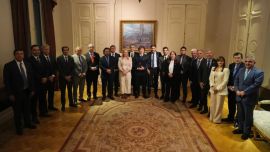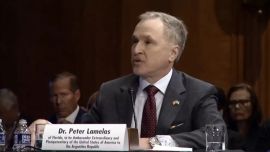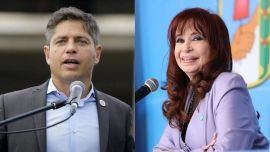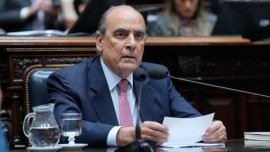When in trouble over the ‘$LIBRA Cryptogate’ scandal back in February, President Javier Milei said that he needed to “build a wall” around himself to prevent alleged scammers from getting close to him. What he ended up building instead was a wall of US dollars at the Central Bank.
Just like last Septemberwith the ‘blanqueo’ whitewash tax amnesty, the government has now received a major – and larger-than-expected – influx of cash following the arrival of the the initial US$12-billion disbursement from the International Monetary Fund, which has lifted the Central Bank’s international reserves to their highest level in two years, some US$38.6 billion – and the best figure since Milei took office in December 2023.
Milei and Luis Caputo, his economy minister, celebrated noisily this week, as they also enjoyed a better-than-expected reaction from the markets to their decision to lift most of the ‘cepo’ capital controls and let the peso float to between 1,000 and 1,400 pesos per greenback. The initial devaluation hit 12 percent, but the exchange rate remains well below the height parallel exchange rates were at on the day the IMF agreement was announced.
With a greater stock of hard currency in its coffers, the government is confident it can make it to the midterm elections in October without major volatility. But this relative calm — won by force of debt — should not obscure the storm that was brewing before the cash injection, nor the one that could build up again if the economic team does not change some of its ways moving forward.
The storm is multi-faceted. Foreign exchange stability will not entirely spare Argentines from higher inflation over the next month or two. Prices went up 3.7 percent in March – much higher than the government had anticipated (even before the peso was allowed to float). Anybody shopping these days can see prices rising to match the (actual or anticipated) devaluation. If pockets were already thin, they will be thinner by the time high election season begins.
Following the stockpile celebrations, all eyes should now move onto cash flow. Against all predictions, the IMF did not just give the government the cash it needed to repay its debt with the IMF — most of the US$20 billion is coming in cash and upfront. The programme's rationale is that the new cash will allow Milei to speed up lifting the capital controls to encourage investment. This, in turn, will generate the confidence Argentina needs to return to international debt markets and secure the funds to repay the IMF.
It is a risky bet, from both sides. The IMF is clearly dealing Argentina another political hand — one that happens every time there is a pro-market, centre-right or right-wing government. Milei can take credit for the fact that his good vibes with Donald Trump have finally paid off, as epitomised by the visit this week from US Treasury Secretary Scott Bessent, who it’s fair to say had other, more important matters to attend to amid the global trade war his boss has unleashed.
For Milei, the risk is stumbling over the same stone that brought him here in the first place. In mid-2024, the government began to over-appreciate the peso in a way that drained the Central Bank for the sake of anchoring inflation more quickly than the natural course of events would allow. He also benefitted local financial investors with juicy returns if they invested in peso instruments at a real interest rate in dollars that would beat any relatively safe investment in the world. Market experts call that “carry trade.” Argentines have for decades had a more colloquial expression for it: bicicleta financiera (no translation needed).
With the cepo lifted, this hamster wheel of easy financial gains is now available to foreign investors as well — especially those who, for one reason or another, have access to the official exchange rate market (importers, for instance). The government has now opened the gate for foreign investors to come, invest, stay, and leave after six months with no restrictions. Coincidentally, the October midterm elections happen in exactly six months.
Is the stone too obvious and too big for everyone to see? Former president Mauricio Macri, who is slowly but surely turning from friend to foe for the Milei government, was a good witness to the harm caused by riding the speculative merry-go-round too fast and for too long during his 2015–2019 administration. Another former president, Cristina Fernández de Kirchner, stretched the comparison too far and likened Milei to Fernando de la Rúa, the president who resigned halfway through his term in December 2001, exactly a year after receiving mammoth assistance from the IMF.
Better get on your bike and away from there.




















Comments